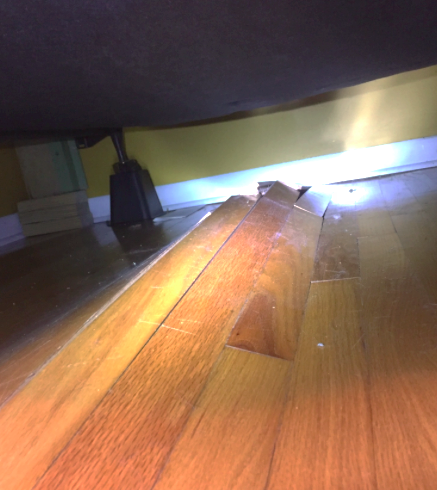“We love our hardwood floors. They are clean, elegant, and withstand the harsh foot traffic of kids, pets, and parties. If we take care of our floors, they should last the entire life of the home! In that senses, they are a great economical and sustainable choice. So, what should we do to maintain our beautiful investment?”
The #1 thing to focus on is humidity control.
To understand why this is the case, let’s talk science for just a moment.
Wood is hygroscopic, meaning it gains and loses moisture as the humidity around it changes. Eventually, the wood will come into equilibrium with the surrounding air’s moisture content; this state is known as equilibrium moisture content, or EMC. If the EMC decreases – that is, if the wood dries out – it will shrink; if the EMC increases the wood will expand. To prevent this from happening, measures are taken before the lumber is milled at the manufacturing facility; it must be dried out and then stored in a clean, dry, enclosed facility with proper ventilation.
Ok, enough science talk; let’s get practical. Once installed, wood floors will expand and shrink depending on indoor air conditions – to what degree depends on the severity of the situation. When humidify changes gradually over the course of a season, say transitioning from a humid summer to a dry winter, the effects on the wood floors will be gradual. For example, you may notice that the gaps between the floor panels become wider in the winter months as moisture levels decrease and the wood dries out and shrinks. If indoor humidity (or lack there of) becomes extreme, cracking, cupping, crowning, or buckling can become severe (note that slight cupping and crowning is a normal phenomena).
- Cracking: If indoor humidity levels plummet, cracks can widen up to the width of a dime for typical 2 ¼” wood paneling. The wood should return to normal once the humidity rises. To keep air humidified in dry winter months, you can install a humidifier.
- Cupping: Cupping occurs when the floorboards become well-shaped. Humidity drives this phenomenon. It will also occur if water is spilled on the floor and absorbs into the wood or if the subfloor becomes damp due to a basement leak that migrates up into the floor or from a moisture-laden crawlspace. To solve this problem, the source of the moisture must be identified. In most cases, this involves controlling indoor humidity levels.
- Crowning: Crowing occurs when the floorboards become dome-shaped. Like cupping, this can occur when the surface of the floor encounters moisture. It happens most often, though, when floors that become cupped get sanded before they dry completely. The high edges seen in the cupping state get sanded down too much and as a result become shorter than the remainder of the panel. Doh!
- Buckling: Buckling is the most destructive result of moisture. When this happens, the wood flooring pulls away from the subfloor and rises as high as several inches. It is possible to repair buckling, but if the underlying cause (moisture) is not address, it could easily happen again.

Controlling moisture can help preserve the life of your hardwood floors. You can control humidity levels in your home by creating a tight building envelope, sealing the crawlspace, and utilizing mechanical systems for proper ventilation. This is just one example of how a high-performance home offers many benefits beyond comfort and efficiency.
Prepare your crawlspace for the heat of summer and preserve your home’s beauty. Cleaning out and cleaning up the crawlspace can help prevent not only moisture issues, but allergies, mold, mildew, and unwanted pests too. Let E3 take care of the dirty work, give us a call today!









